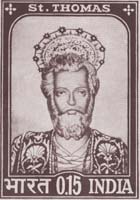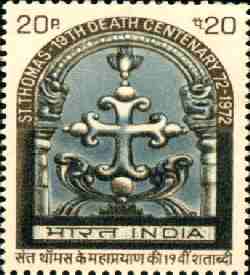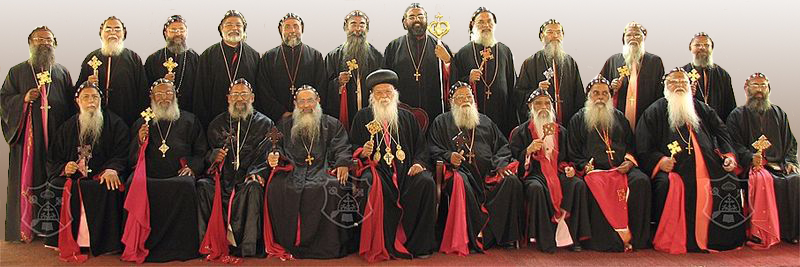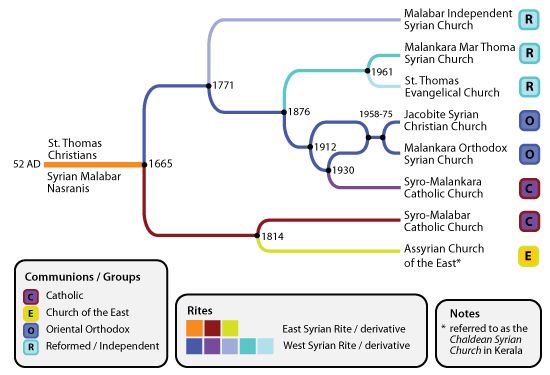Timeline of Oriental Orthodoxy in India (St. Thomas Christianity)
| Autocephalous Churches |
| Armenia | Alexandria | Ethiopia | Antioch | India | Eritrea |
| Autonomous Churches |
| Armenia: Cilicia | Jerusalem | Constantinople Antioch: Jacobite Indian |
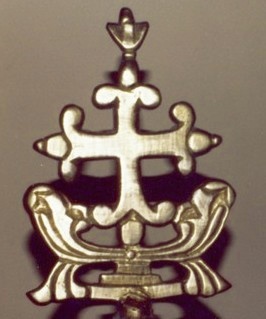
The Nasrani Menorah or the Mar Thoma cross.
This is a timeline of Oriental Orthodoxy in India.[note 1] Thomasine Christianity is found in the southern Indian state of Kerala. These churches trace their roots back to St. Thomas the Apostle who arrived along the Malabar Coast in the year AD 52.
Tradition says that at the dispersal of the Apostles after Pentecost, Saint Thomas was sent to evangelize the Parthians, Medes, Persians and Indians; he ultimately reached South India, carrying the Faith to the Malabar coast, which still boasts a large native population calling themselves “Christians of St. Thomas.”[note 2]
Contents
St. Thomas Christians (52-1498)
Ancient Era (52-431)
- 40 Apostle Thomas is brought before King Gondophares, in Takshasila in North India (Pakistan).[note 3]
- 52 Arrival of St. Thomas the Apostle in Muziris (near Kodungalloor)[note 4] in the Indian state of Kerala, founding the Church in India.
- 52-72 St. Thomas converted and baptized many caste Hindus including thirty-two Namboori (Brahmin) families and certain members of the royal family, Namely, Bana Varma Perumal and his nephew who later became Kepa, the first Archbishop of Kerala; St Thomas established 7 churches at: Kodungalloor; Palayoor; Paravur; Kokkamangalam; Chayal; Niranam; and Kollam.[note 5]
- 72 Martyrdom of St. Thomas the Apostle, in the neighborhood of Mylapore, city of Chennai, state of Tamil Nadu.[note 6]
- 105 Church established at Kuravilangad (St. Mary’s Forane Church).
- 189 Arrival of Stoic Philosopher Pantaenus from Alexandria, who visited the Malankara Church[note 7] at the request of the Malankara Christians (reported by Eusebius of Caesarea and Jerome);[note 8] according to Eusebius, Pantaenus was for a time a missionary preacher, traveling as far as India, where it was reported that he found Christians who were using the Gospel of Matthew in Hebrew.
- 196 Bardaisan writes of Christians amongst the Parthians, Bactrians (Kushans) and other peoples in the Persian Empire .
- 230 Veera Raghava Chakravarthy, the King Emperor of Kerala, who had his capital at Kodungallor, granted to the Nazaranis a series of royal honors, by a proclamation engraved on copper plate called "cheped."
- 290 Brief persecution of Persian Christians under Bahram II.
- ca.300 Bp. David of Basra undertook missionary work in India, among the earliest documented Christian missionaries in India.[note 9]
- 325 First Ecumenical Council in Nicaea; St. Jacob of Nisibis, Bp. of Nisibis in Mesopotamia and spiritual father of Ephrem the Syrian, attended the First Ecumenical Council, as did Persian Bp. John (Mar Yohannan) presiding over the churches "in Persia and India".[note 10]
- 327 Apparition of Theotokos at Kuravilangad.
- ca.4th-6th c. Severe persecution of Christians in Persia (Sassanid Empire).
- 337-379 The Persian Church faced several severe persecutions, notably during the reign of Shapur II (309–79), from the Zoroastrian majority who accused it of Roman leanings.[note 11]
- 340-360 The Nasranis were granted special rights and privileges by the edict Thazhekad Sasanam; the edict was written on stone and provides proof of the early existence of St. Thomas Christians in Kerala.
- 345 A small group of K'nanaim merchants travelled to the Jewish trade posts at Kodungallur in Kerala and settled there; their descendants are today known in Kerala as Knanaya Nasranis (Saint Thomas Christians); they were under the leadership of Thomas of Cana (Thomas of Kynai), with Bishop Joseph of Edessa (Bp. Uraha Mar Yausef), four priests, several deacons, and 72 Syro-Aramaic Jewish families who migrated from Edessa (about 400 people).
- 354 Theophilos the Indian was sent by Emperor Constantius II on a mission to south Asia via Arabia, where he is said to have converted the Himyarites and built three churches in southwest Arabia; he is also said to have found Christians in India, along the Malabar Coast, as recorded by the Anomoean (Arian) Church historian Philostorgius.
- 363 St. Ephrem the Syrian at Edessa, writes about St. Thomas as the Apostle of India.
- 379-402 Continuation of the Great Persecution of the Persian church.
- 380 St. Gregory the Theologian writes about St. Thomas as the Apostle of India.
- 390 St. Ambrose of Milan writes about St. Thomas as the Apostle of India.
- 400 St. Jerome writes about St. Thomas as the Apostle of India.
- 409 Permission was formally given by the Zoroastrian King Yezdegerd to Christians to worship openly and rebuild destroyed churches, though they were not allowed to proselytize (some historians call this decree the Edict of Milan for the Assyrian Christian church).
- 410 The Council of Seleucia-Ctesiphon, also called the Council of Mar Isaac, met in AD 410 in Seleucia-Ctesiphon, capitol of the Sassanid Empire of Persia, extending official recognition to the Empire's Christian community, (known as the Church of the East after 431 AD), and established the Bishop of Seleucia-Ctesiphon as its Catholicos, or leader, declaring him to be supreme among the Bishops of the East; this established a hierarchical Christian Church in Iran, with a patriarchate at Ctesiphon and metropolitans in the capitals of five Persian provinces; it also declared its adherence to the decisions of the Council of Nicea and subscribed to the Nicene Creed.
- 424 Schism begun: Formal separation of the Assyrian Church of the East ("East Syrian Church", "Persian Church", "Chaldean Syrian Church", or "Nestorian Church"), from the See of Antioch: the Synod of Dadyeshu met in Markabata of the Arabs, under the presidency of Mar Dadyeshu, proclaiming the independence of the Iranian Church from Byzantium, deciding that the Catholicos should be the sole head of the Church of the East and that no ecclesiastical authority should be acknowledged above him, referring to him for the first time as Patriarch, answerable to God alone (thus also reassuring the Sassandid monarchy that Persian Christians were not influenced by the Roman enemy).
Persian (Nestorian) Era (431-1498)[note 12]
- 431 The Third Ecumenical Council is held in Ephesus, condemning Nestorianism.
- ca.450-650 Nestorian missionary movements were very active: the Assyrian Church of the East headquarterd in Seleucia-Ctesiphon, had spread into Egypt, Syria, Arabia, Mesopotamia, Persia, India, Ceylon, China, and Mongolia.[note 13]
- 484 The Catholicos-Patriarch of the Church of the East Babowai (457–484) was executed by Sassanid king Peroz I, for his pro-Byzantine leanings, for which he was often in conflict with other members of the anti-Byzantine Church of the East (i.e. such as Barsauma).
- 484 Schism finalized: Synod of Beth Lapat is convened under the Metropolitan of Nisibis Barsauma, declaring Nestorianism as the official theology of the Assyrian Church of the East, effectively separating the Assyrian church from the Byzantine church, pleasing the Zoroastrian Persian kings, who were at constant war with the now Christian Byzantine Empire.
- 489 Emperor Zeno I closes Nestorian academy in Edessa, which was then transferred under Sassanian Persian auspices to Nisibis, becoming the spiritual center of the Assyrian Church of the East.
- 522 Byzantine monk Cosmas Indicopleustes (literally "who sailed to India") visits the Malabar Coast and Ceylon, writing about Christian Communities in his book Topografia Christiana.
- 595 Patr. Sabrisho persuaded Chosroes II (r. 591–628) to grant Christians freedom of worship.
- 629 The Oriental Orthodox wing of the Church in Persia, that continued to be under the Syriac Orthodox Patriarchate of Antioch & all the East, was reorganized, with the creation of the position of Maphrian (Exarch) of the East, holding second rank after the Jacobite Patriarch of Antioch, granting the Syrians in the Persian Empire (which was officially Nestorian) a large ecclesiastical autonomy.
- 708 Death of Bp. Jacob of Edessa, one of the most distinguished Syriac writers.
- 715 Very first Muslim invasion of India occurred, as Umayyad general Muhammad bin Qasim conquered the Sindh and Punjab regions along the Indus river (now a part of Pakistan).
- ca.800 The Church of St. Sebastian in Thazhekad is founded, one of the oldest in Kerala, dating back to AD 800; it is currently the largest pilgrimage center in the Roman Catholic Syro-Malabar Diocese of Irinjalakuda.
- ca.825 Two Bishops, Mar Sabrisho and Mar Peroz (Prodh), along with several families, had migrated to Kollam; these two Bishops administered the whole of the Syrian Church, with Mar Sabrisho keeping his head quarters at Kollam, and Mar Peroz at Kodungalur; they were responsible for the construction of churches at many places in Kerala and the churches built by them were known as Kantheeshangal.
- 825 Copper-plates known as the Tharisapalli plates[note 14] were given by a Venad Indian King to the Nestorian Bishop Mar S(abo)r Easho (Easow-data-veeran), documenting a land grant near "Kollam" to Nestorian Christians who had taken the then famous Red Sea route to the state of Kerala; the plates document the granting of 72 royal privileges of the Nazranies, and give information about the arrival of Monks from Persia, led by the Marwan S(abo)r iso ; Commencement of the calendar known as the Malayalam calendar (Malayalam Era, Quilon Era, or Kollavarsham), a solar Sidereal calendar used in the state of Kerala (part of the Aryanised version of the older Tamil calendar which was in usage till then); Christianity as a religion takes shape in Kerala.
- 829 The Udayamperoor (Diamper) church was built.
- 869 Council of Capharthutha was held in February to resolve the differences between the Patriarchate of Antioch and All the East (Syriac Orthodox Church) and the Maphriyan (Exarch) in Persia and India; it aimed to regulate the relationship and resolve frequent difficulties arising between the two positions, codifying eight canons dealing with the Patriarch and the Maphrian of Tigris.
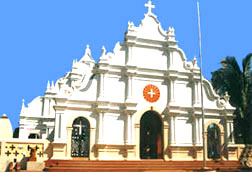
Mulanthuruthy Marthoman church, a pilgrimage center for St. Thomas Christians.
- 883 King Alfred of England sent the Bishop of Marborne in 883 with offerings to the tomb of St. Thomas, to fulfill a vow he had made when the Danes attacked him.
- 988 Since in the tenth century, it seems there was no bishop for a long time, as a result of the continued request of the Kerala Nazaranis, the Metropolitan of Mesopotamia sent a bishop named Mar John in 988, another Mar John in A.D 1000, and Mar Thomas in 1056.
- ca. 11th c. Antioch claims to have had jurisdiction over Kerala during the eleventh and early twelfth centuries; the Greek Patriarch of Antioch is said to have sent a Catholicos to the Melkites and another to Baghdad, the latter of whom sent bishops to India.[note 15]
- ca.1100-1125 The Mulanthuruthy Marthoman church is constructed, being among the ancient and famous churches of the Malankara Church and a pilgrimage center for St. Thomas Christians, containing a relic of St. Thomas, which was brought from Mosul.[note 16]
- 1122 Mar John III, Metropolitan designated Patriarch of India, with his suffragens went to Constantinople, and thence to Rome, telling of miracles associated with St. Thomas that occurred in the land of India.
- 1264 Bp. Bar-Hebraeus is made Primate, or Maphrian,[note 17] of the East by Patr. Ignatius IV Yeshu (1264—1282).
Arrival of the Roman Catholics
- 1291 Italian Franciscan missionary John of Montecorvino, arrives in the Madras region or "Country of St. Thomas", where he preached for thirteen months and baptized about one hundred persons.
- 1292 Venetian traveller Marco Polo arrives in India on the Coromandel Coast, visiting the tomb of St. Thomas (at Mylapore).
- 1323 French Dominican friar Jordanus Catalani de Severac arrives in Kollam (Quilon).
- 1329 August 9, erection of the first Roman Catholic Diocese in India, in the state of Kerala, being the Diocese of Quilon (or Kollam); re-erected on September 1, 1886.[note 18] French Dominican friar Jordanus Catalani de Severac is appointed as the first Bishop of Quilon.
- 1490-1503 East Syrian mission to India: two Chaldean bishops, John and Thomas, in Kerala.[note 19]
- 1494 June 7, Treaty of Tordesillas: division of the world and mission lands between Spain and Portugal.
Era of Divisions (1498-1912)
Portuguese Colonial Era (1498-1653)
- 1498 Arrival of Vasco da Gama and the Portuguese, reaching the Indian shore, along with Roman Catholic missionaries.
- 1500 Pedro Álvares Cabral's fleet carried a vicar, eight secular priests, and eight Franciscans to Kozhikode (Calicut).
- 1503 Mar Yabella, Mar Denaha, and Mar Yakoob from Persia went to Kerala.
- 1514 The Portuguese Padroado system is begun.
- 1517 The Portuguese discover the tomb of St. Thomas in Mylapore.
- 1518 The "Book of Duarte Barbosa" mentions St. Thomas and his tomb at Mylapore, narrating the legends regarding the martydom of St Thomas, also that local Christians go there on pilgrimage and carry away many relics.
- 1530 Goa becomes the capital of Portuguese India.
- 1533 Portuguese establish the Latin Diocese of Goa in the hope of bringing the St. Thomas Christians under their jurisdiction.
- 1540 The Franciscan Fr. Vincent De Lagos starts the Cranganore Seminary.
- 1542 Francis Xavier, Apostolic Nuncio in the East, reaches Goa.
- 1545 Francis Xavier was at Mylapore for four months, spending long hours nightly in prayer at the tomb of St. Thomas; Francis Xavier requested the Inquisition in 1545.
- 1548 Dominican Monastery founded in Cochin.
- 1549 Mar Abuna Jacob, A Chaldean Bishop, stayed at St. Antonio Monastery, Cochin.
- 1552 Schism: a split occurred within the Assyrian Church of the East, when part of it joined Rome, so that besides the Catholicosate of the East another, “Chaldaean,” Patriarchate was founded, the Uniate Chaldean Catholic Church, headed by the Patriarch Mar John Sulaqa (1553-1555); apparently both parties sent Bishops to India.
- ca.1556 Assyrian Church of the East Catholicos, Simeon VII Denkha (Shemʿon VII Ishoyahb (1538-58)) sent a prelate to India, in the person of Mar Abraham, who was later to be the last Syrian Metropolitan of Malabar, after having gone over to the “Chaldaean” side; the Roman Catholic “Chaldaean” Patriarch Abdisho IV (1555-1567) sent Mar Joseph to Malabar as a “Chaldaean” bishop, accompanied by another “Chaldaean” bishop, Mar Eliah.
- 1557 Pope Paul IV erects the Diocese of Cochin; Canonization process of Francis Xavier begun at Cochin.
- 1560 The Goa Inquisition was established in the Indian state of Goa and the rest of the Portuguese empire in Asia.[note 20]
- 1577 Vaippicotta Seminary of the Jesuits started.
- 1579 Augustinians reached Cochin.
- 1585 In a Goan Synod it was decided to introduce the Latin liturgy and practices among the Thomas Christians.
- 1597 Mar Abraham, the last Metropolitan Archbishop appointed by the Chaldean Patriarch, died.
- 1599 June 20-June 26, The Synod of Diamper, convened by the Portuguese archbishop Aleixo de Meneses, issued 200 decrees, including removing the Malabarese from the jurisdiction of the Chaldean (Nestorian) patriarch, severing their direct ties with the Assyrian Church of the East, and placing them under the Latin-rite Portuguese; Latinized the liturgy; decreed priestly celibacy; and introduced the Inquisition; the synod enforced severe restrictions on the faith of the Syriac Saint Thomas Christians, and the practice of using Syriac/Aramaic (Persecution of Syrian Christians).
- 1606 Pope Paul V, in elevating San Thome of Mylapore to a cathedral, declared that “there lay buried the body of St. Thomas.”
Jacobite Era: The Marthoma Metrans & Malankara Metropolitans (1653-1912)
- 1653 January 3, Coonan Cross Oath at Mattancherry, Cochin, by which all connections with the Portuguese Roman Catholics and Jesuits (Roman Catholic supremacy) was rejected by the St Thomas Christians; about 25,000 Saint Thomas Christians and 633 clergy led by Archdeacon Thomas declared independence against the foreign aggression, by holding on to a rope which was tied around the stone cross in front of the church in Mattancherry, and taking an oath rejecting and pubicly avowing the supremacy of the Roman Catholic Church over them; Archdeacon Thomas was consecrated by 12 priest elders as Mar Thoma I, the first bishop of the Malankara Church.[note 21]
- 1653-1670 Mar Thoma I, also known as Valia Mar Thoma, was the first bishop of the Malankara Church.
- ca.1659-1663 The Dutch East India Company conquered the entire Malabar Coast from the Portuguese, almost entirely driving them from the west coast of India; when news of a peace agreement between Portugal and the Netherlands reached Asia in 1663, Goa was the only remaining Portuguese city on the west coast.
- 1661 Pope Alexander VII sent Syrian Bp. Sebastiani at the head of a Carmelite delegation to Malabar, in order to establish a hierarchy of the Roman Catholic Chaldean (formerly Nestorian) rite under Rome, in order to pacify the distressed St. Thomas Christians.
- 1663 Schism: Syro-Malabar Catholic Church is formed, when most of the St. Thomas Christians (84 out of 116 communities) cut their ancient ties with the churches in Persia and joined the Roman Catholic Communion in 1663 AD, with the ordination of Chandy Bishop (Alexander de Campo) as the first Syrian Vicar Apostolic Malpan of Malabar; this section was called the Old Party (Pazhayakuttukur); the rest of the Malankara communities (32) joined the Syrian Jacobite (Monophysite) Church, brought to Malabar in 1665 by Bishop Gregorios from Jerusalem; the Dutch East India Company captures Cochin from the Portuguese (i.e. from 1503 to 1663, Fort Kochi was ruled by Portugal).
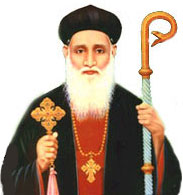
St. Gregorios Abdul Jaleel of Jerusalem (+1681), playing a crucial role in the defense of Oriental Orthodoxy in India.
- 1665-1681 Oriental Orthodox Metr. of Jerusalem Mar Gregorios Abdul Jaleel played a crucial role in India in the defense of the Oriental Orthodox faith and Suryani tradition following the Coonan Cross Oath (Koonan Kurishu Sathyam).[note 22]
- 1665 "Jacobite" bishop, Mar Gregorios Abdul Jaleel of Jerusalem came to India, confirming the Episcopal consecration of Mar Thoma I as the head of the Orthodox Church in India; this was a new beginning in the history of the modern Malankara Church; the Western Syrian language and Antiochene liturgy was adopted in their church; those who accepted Mar Gregory became known as the New Party (Puthankuttukar); thus started the connection with the Syrian Orthodox Church of Antioch, in 1665.[note 23]
- 1670-1686 Mar Thoma II
- 1686-1688 Mar Thoma III
- 1688-1728 Mar Thoma IV; during his period the Church passed through a number of persecutions.
- 1728-1765 Mar Thoma V; during his tenure a number of Bps. from Antioch arrived.
- 1748 Mar Ivanios a Bp. from Antioch arrived; he lived in the Mulanthuruthy Church and taught Syriac to the Deacons; his teachings were unacceptable to the Malankara Church and so in 1751 he was banished from Kerala; before leaving for Antioch, Mar Ivanios ordained Kattumangattu Abraham and Geevarghese as priests, who later became the founding fathers of Malabar Independent Syrian Church in 1772.
- 1751 The Patr. of Antioch Mar Ignatious Geevarghese III (Ignatius George III, 1745-1768) sent Mar Baselios Shakrilla, Mar Gregorius, Ramban Yuhanon, Geevarghese Korepiscopa, Yuhanon Kassessa and four other priests who arrived at Cochin in 1751.
- 1761 Mar Thoma V consecrated Mar Thoma VI as his successor; he did it without any assistance from foreign Bishops thus severing all allegiance to foreign bishops.
- 1765-1808 Mar Thoma VI (Dionysious I).[note 24]
- 1770 To avoid a split in the Church Mar Thoma VI accepted re-consecration and the title Dionysius from Antiochan bishops.
- 1772 Schism: West Syrians under the leadership of Abraham Mar Koorilose, Metropolitan of Malankara, formed the Malabar Independent Syrian Church, splitting from the main body of India's Malankara Church over concerns about the authority of the Syriac Orthodox Patriarch of Antioch.[note 25]
- 1772-1858 The British East India Company rule in India, establishing a capital in Calcutta, appointing its first Governor-General, Warren Hastings, and becoming directly involved in governance.
- 1795 The British captured Malabar, Kerala.
- 1798 A Nestorian bishop Mar Gabriel arrived in Malabar in 1798, however neither the Malankara church nor the Roman Catholics accepted him.
- 1806 The Marquis of Wellesley, the British Governor General of India, Cecil Cherian, sent the Rev. Claudius Buchanan, an Anglican priest, to conduct research into the life of the ancient Church of St.Thomas in India; Rev. Dr. Claudius Buchanan visited Mar Thoma VI and made arrangement for the translation of the Bible into Malayalam - Marthoma VI gave him the manuscript of the Bible written in the oldest Syrian, and this manuscript was later deposited in the public library of the University of Cambridge.
- 1808-1809 Mar Thoma VII.
- 1809-1816 Mar Thoma VIII; he was a man of vision, and it was during his tenure that the Malankara church opened the first formal educational institution, in Kerala.
Arrival of the Protestants - Further Splits (1813-1912)
- 1813 The Church Missionary Society's (CMS) work in India is begun.
- 1814 Schism: The Chaldean Syrian Church separated from what later became known as the Syro-Malabar Catholic Church, claiming to continue the pre-Portuguese east-Syrian Nestorian tradition, as an Independent Orthodox Church.
- 1815 Orthodox Pazhaya Seminary (Old Syrian Seminary) in Kottayam, is founded, the first Syrian Orthodox Christian school of theology in Asia.
- 1816-1817 Mar Thoma IX.
- 1816-1816 Pulikkottil Joseph Mar Dionysious I (Mar Thoma X) (Dionysious II), was the Metropolitan only for nine months, but he made lasting contributions to the Malankara church; he was able to keep up the traditions, improve the knowledge of the people and decree that the assets of the Metropolitan would be assets of the Church; with him, the reign of Marthoma Metran came to an end, and the power was transferred to the Malankara Metropolitan.
- 1817-1825 Punnathara Mar Dionysious (Mar Thoma XI) (Dionysious III).
- 1817 The CMS began the CMS College Kottayam, to teach English.
- 1818 CMS work in Ceylon is begun.
- 1825-1852 Cheppad Philipose Mar Dionysius (Mar Thoma XII) (Dionysious IV).
- 1825 The Church of England's Bp. of Calcutta Reginald Heber performed the first ordination of an Indian, Abdul Masih (Servant of Christ), for mission work in India.[note 26]
- 1852-1877 Mathews Mar Athanasius Metropolitan (Mar Thoma XIII), a pro-protestant reformist; during his time Reformation of the Church became strong; one cleric who objected to the Reformation (Ouseph Kathanar from Kunnamkulam) went to Antioch, and was consecrated as Joseph Mar Dionysius on April 3, 1865; Mathews Mar Athanasius' successor was one Thomas Mar Athanasius (Mar Thoma XIV) (1877-1893), the first Metropolitan of the schismatic Mar Thoma church in 1877, a Reformed West-Syrian Rite (Protestant Oriental) church, in communion with the Anglican Church.
- 1865-1909 Pulikkottil Joseph Mar Dionysious II (Dionysius V), a courageous, popular, spiritual leader, who guided his followers through one of the most difficult times in the history of Malankara Church.
- 1875-1877 Apostolic visit to India by Patriarch Moran Mor Ignatius Ignatius Peter IV.
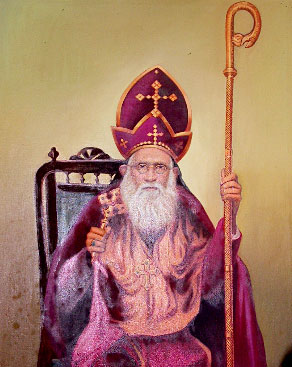 Metr. Antonio Francisco Xavier Alvares, the first (Roman Rite) Orthodox Metropolitan of Goa-Ceylon (1889-1923).
Metr. Antonio Francisco Xavier Alvares, the first (Roman Rite) Orthodox Metropolitan of Goa-Ceylon (1889-1923).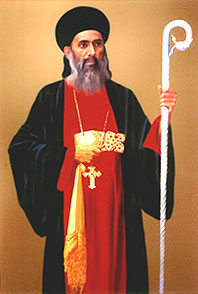 Gheevarghese Mar Gregorios of Parumala, the first Saint of both Oriental Orthodox Churches in India.
Gheevarghese Mar Gregorios of Parumala, the first Saint of both Oriental Orthodox Churches in India. - 1876 The Council of Mulanthuruthy (of the Malankara Church) is convened at the historic Mulanthuruthy Marthoman church, presided over by Patriarch Ignatius Peter IV (who had been summoned to assist in efforts against the inroads of Protestantism that were supported by the British), declaring that the Malankara Church accepted the supremacy of the Patriarch and that it would keep the Jacobite faith of the Antiochians; this synod thus represented the inauguration of an official relationship of a section of the Indian Orthodox Church with the Patriarch of the West Syrian Church; another section however representing several churches did not participate, saying that this was against the historical status of the Malankara Church.[note 27]
- 1876 Schism: the Mar Thoma Church[note 28] (Anglican Communion) came into being under Thomas Mar Athanasious, who was excommunicated by the Jacobite Patriarch; they were known as Reformed Jacobites before the group took the name of Mar Thoma Church, introducing many changes based on Protestant doctrine.
- 1888 Significant transfer movement from the Catholic to the Oriental Orthodox church: the Latin rite (Uniate) Independent Catholic Church of Ceylon, Goa, and India was formed, consisting of about 5000 Catholics under Antonio Francisco Xavier Alvares (Alvares Mar Julius), who was consecrated in 1889 by St. Gregorios of Parumala, Metr. Athanasius Paulos of Aluva, and Malankara Metr. Dionysius Joseph II; this church maintained relations with the Syrian Orthodox Patr. of Antioch Mar Ignatius Peter III, and was permitted to continue its Latin or Western rite liturgical practices.[note 29][note 30]
- 1902 Death of Gheevarghese Mar Gregorios of Parumala, later canonized by both the Jacobite Syrian Orthodox Church and Indian Orthodox Church (1947), being the first Saint of both Oriental Orthodox Churches in India.
- 1909-1934 Geevarghese Mar Dionysius of Vattasseril (Dionysius VI); he led the Church as Malankara Metropolitan until his death in 1934, when he and the Church triumphed in establishing the official Constitution of the Malankara Orthodox Syrian Church.
- 1910 Formation of the Archdiocese of Knanaya, of the Syrian Orthodox Church.
Modern Era (1912-Present)
Indian Orthodox Church: Autocephalous Era (1912-Present)
- 1912 Schism: Church of India ('Methran Kakshi' (Bishop's Party)) declares autocephaly from the Jacobite Church of Antioch (Syriac), after a vertical split in the Malankara Church in 1911;[note 31] with the declaration of autocephaly, the the Catholicate of the East was relocated to India, which historically had been in Seleucia and later in Tigris; consecration of the first Indian Catholicose, Moran Mar Baselios Paulos (1912-14), the first Catholicose of the East in India, with the participation of (deposed) Patriarch Ignatius Abdul Messiah of Antioch and (excommunicated) Malankara Metropolitan Geevarghese Dionysius (Vattasseril Mar Divannasios);[note 32] the Malankara Jacobite Syriac Orthodox Church ('Bava Kakshi' (Patriarch's Party)) on the other hand, remained as an autonomous jurisdiction of the Church of Antioch (Syriac).
- 1925-1928 Baselios Geevarghese I (sucesssor to Moran Mar Baselios Paulos (1912-14) as Catholicose of the East).
- 1929-1964 Baselios Geevarghese II, the 3rd Catholicos of the East and Malankara Metropolitan (had both titles, after 1934).
- ca.1930's Roman Catholic Vellalar Christians (Trichy) separated themselves temporarily from their church because of caste quarells, and employed Orthodox West Syrian Indian Priests from Kerala to conduct their worship services.
- 1930 Schism: The Syro-Malankara Catholic Church is established as an Eastern rite of the Roman Catholic Church, when a large group of Jacobites under the leadership of Archbishop Mar Ivanios split from the Malankara Church and subsequently entered into communion with Rome; they were allowed to maintain their Antiochene liturgy; death of Metr. Eustathius of Kunnamkulam (glorified in 2000).
- 1931 Patriarch Elias III came to Malankara at the invitation of the then British Viceroy, Lord Irvin, to resolving the schism that had erupted in the Malankara Church; the Thrikkunnathu Seminary is opened (operating from 1931-1977), being a notable Malankara teaching facility for clergy in the northern dioceses of the Indian Orthodox Church, and the only full seminary for Jacobite Syrian Christians (later noted as the "headquarters" of the Jacobite Syrian Christian Church in India).
- 1932 Death of Patriarch Elias III, the only Syriac Orthodox Patriarch of Antioch who is entombed in Kerala, India; the monastery where he is entombed is a renowned pilgrim centre, known as Manjanikkara Dayara.
- 1934 Establishment of the Constitution of the Orthodox Church in India as an autocephalous Church, linked to the Orthodox Syrian Church of the Patriarch of Antioch; death of Geevarghese Mar Dionysius of Vattasseril, Malankara Metropolitan of the Indian Orthodox Church; from 1934 onwards, the two offices of Catholicos of the East and Malankara Metropolitan were united in one person, known as the Catholicos of the East & Malankara Metropolitan.
- 1947 Canonization of Gheevarghese Mar Gregorios of Parumala (+1902) by the Church of India, the first saint canonized by the church; canonization of Eldho Mor Baselios of Kothamangalam (+1685) by the Church of India, the second saint canonized by the church.
- 1947 The Dominion of India gains its independence from the United Kingdom, as British India is dissolved; a largely Hindu India and a Muslim Pakistan are created by partitions of the subcontinent, with Punjab and Bengal divided along religious-demographic boundaries between the two.
- 1952 Immediately after the "All Kerala Celebrations of the 19th Century of the Landing of St. Thomas in India," Cardinal Tisserant brought a part of St. Thomas' relics back to India, with the main portion enshrined at Kodungalloor where the Apostle first set foot in India, and the other portion at Mylapore where he died.
- 1956 Ethiopian Emperor Haile Selassie visited Kerala, gifting the Syrian Orthodox Church of St. George ("Cheppad Church") with a Gold Ethiopian Cross and a Holy Bible with gold engravings written in Amharic.
- 1958 Unification of the Malankara Church again (lasting from 1958-1975), after the split in 1912: on September 12, the constitutional bench of the Supreme Court of India recognized the validity of the Catholicate and unanimously declared that the Patriarch of Antioch does not have any authority over the Malankara church and that the Indian church is completely free under the Catholicos of the East; by an accord, Syrian Patriarch Moran Mor Ignatius Ya`qub III affirmed his canonical acceptance of the Catholicate as well as the 1934 Constitution of the Indian Orthodox Church; the two factions of the Malankara Church, viz; Jacobite and Orthodox, re-united.
- 1964 Patriarch Moran Mor Ignatius Ya`qub III visited India and consecrated Mor Augen Thimotheos as the Catholicose of the East; thus 'Mar Baselios Augen I', the Metropolitan of Kandanad diocese, became the first “canonically” ordained Catholicose/Maphriyono of the East from India (from the Jacobite point of view); the government of India brought out a stamp of St. Thomas, in connection with the Bombay International Eucharistic Congress and the visit of Pope Paul VI to India in 1964.
- 1964-1975 Baselios Augen I, was the first Catholicose of the East of the United Malankara Church (Jacobite Syrian Orthodox Church and Malankara Orthodox Syrian Church), and remained as the Catholicose of the Malankara Orthodox Syrian Church after the second split in the church in 1975.
- 1965 The Indian Orthodox Church participated in the Ecumenical Council of Oriental Orthodox Churches held in Addis Ababa.
- 1969 The Carmelites of Mary Immaculate (CMI) founded Christ University in Bangalore, the first University by the Roman Catholic Church in India.
- 1972 The new Catholicos Augen I began to claim that he is seated on the Throne of St. Thomas, insisting that the Church in Malankara is autocephalous.
- 1973 Government of India brings out a "19th Death Centenary" stamp of St. Thomas (72-1972).
- 1975 Schism: the Malankara Jacobite Syriac Orthodox Church (Patriarchal, "Jacobite", or Bava Faction) and the Malankara Orthodox Syrian Church (Indian Orthodox Church) (Catholicos, or Methran Faction) split again: a Synod of the Syrian Orthodox Church excommunicated the Catholicos and his followers, while the Catholicos and the Metropolitans convened their own Synod separately, and cut off connections with the Patriarch of Antioch (Syriac); on September 7, 1975, Patriarch Yakub III consecrated Mor Philoxenus of Kandanad (Baselios Paulose II) as Catholicos of the East for the Jacobite faction (1975-1996); the Church of India consecrated Baselios Mar Thoma Mathews I as the new Catholicos (1975-1991).
- 1975-1991 Baselios Mar Thoma Mathews I, the 5th Catholicos of the East & Malankara Metropolitan.
- 1977 The Thrikkunnathu Seminary and its Saint Mary’s Church building were closed in December, owing to an ownership dispute between the Indian (Malankara) Orthodox and the Jacobite Syrian Christian Church.
- 1980 Greek priest-monk Fr. Athanasios Anthides travelled to India to begin a systematic Orthodox Mission in the rural area of Arambah, in West Bengal state, in eastern India..
- 1990 Death of Fr. Athanasios Anthides, first Greek Orthodox Missionary to India (1980-1990), suceeded a year later by priest-monk Fr. Ignatios Sennis, who came to Calcutta to continue the mission (1991-2004).
- 1991-2005 Baselios Mar Thoma Mathews II, 6th Catholicos of the East & Malankara Metropolitan.
- 1995 June 20, the Supreme Court of India unequivocally declared that "The Patriarch of Antioch was undoubtedly acknowledged and recognised by all the members of the Malankara Church as the supreme head of their Church", implying that the Indian Orthodox Catholicate is part of the Syriac Orthodox Church and is not autocephalous.
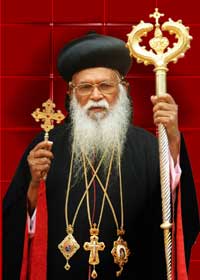 Baselius Marthoma Didymus I, Catholicos of the East & Malankara Metropolitan, Church of India, [2005-Present].
Baselius Marthoma Didymus I, Catholicos of the East & Malankara Metropolitan, Church of India, [2005-Present].

Consecration of Thomas Mar Dionysius as Baselious Thomas I, Catholicose of India (seated) [2002-Present], by the Patr. of Antioch, Ignatious Zakka I Iwas, and the universal episcopal synod. 31 July 2002, Damascus - Malankara Jacobite Syriac Orthodox Church.
- 1996 September 25, the Nagpur St. Thomas Orthodox Theological Seminary was officially inaugurated by H.G. Dr. Geevarghese Mar Osthathios, the President of the Mission Board of the Malankara Church, in the presence of H.G. Stephanus Mar Theodosius and H.G. Geevarghese Mar Ivanius (Kottayam).
- 2000 Patr. Ignatious Zakka I Iwas of Antioch glorified Metr. Eustathius of Kunnamkulam (+1930) as a saint in the Syriac Orthodox Church and the Malankara Syriac Orthodox Church.
- 2002 The two Oriental Orthodox Churches conducted their own Syrian Christian Association meetings, and since then are functioning independently; the Malankara Jacobite Syriac Orthodox Church faction adopted a new constitution, against the constitution of 1934.
- 2003 Canonization of Geevarghese Mar Dionysius of Vattasseril (+1934) by the Church of India, the third saint canonized by the church.
- 2005-present Baselios Thoma Didymos I, 7th Catholicos of the East & Malankara Metropolitan,
- 2008 Canonization of Sister Alphonsa (Anna) Muttathupadath (+1946) in the Vatican by Pope Benedict XVI - the first person of Indian origin canonized a saint of the Syro-Malabar Catholic Church, and the first woman Saint from India.
- 2009 The Government of India issued coins in honour of St. Alphonsa, the first Christian in India to have commemorative coins issued in her honor.
- 2010 February 17, the Malankara association met at Sasthamkotta under the leadership of His Holiness Baselius Marthoma Didymus I, electing seven new Bishops.
See also
- Apostle Thomas
- Addai (Apostle Thaddeus of the Seventy)
- Church of India
- Malankara Jacobite Syriac Orthodox Church
- Assyrian Church of the East ("East Syriac" (Chaldean))
- Church of Antioch (Syriac) ("West Syriac" (Antiochian))
- Oriental Orthodox
Timelines
- Timeline of Church History
- Timeline of Orthodoxy in America
- Timeline of Orthodoxy in Australia
- Timeline of Orthodoxy in the British Isles
- Timeline of Orthodoxy in China
- Timeline of Orthodoxy in Greece
- Timeline of Orthodoxy in Japan
- Timeline of Orthodoxy in New Zealand
- Timeline of Orthodoxy in Russia
- Timeline of Schisms
- Timeline of Orthodox Church and Roman Catholic relations
Notes
- ↑ Several places such as Ethiopia, Arabia Felix etc. once went by the name India. One can not exclude South India any way from this India. South India in particular was known to the early Greeks and Romans. A number of Roman coins, even those of the Republican period are occasionally discovered in Malabar and other parts of South India. Saint Jerome and Saint Ambrose had knowledge about the customs of the Brahmins who certainly were inhabitants of South India. Saint Ephrem, Saint Gregory Nazianzus, Saint Ambrose, Gaudentius, Saint Jerome, Paulinus of Nola, several ecclesiasticl calenders, martyrologies and other works explicity connect Saint Thomas with India.
- ↑ NSC NETWORK. Early references about the Apostolate of Saint Thomas in India, Records about the Indian tradition, Saint Thomas Christians & Statements by Indian Statesmen.
- ↑ St. Thomas preached there for some years, after which, becoming aware of the Dormition of the Blessed Virgin Mary, he went back to Jerusalem; on his second journey, the Apostle came to Malabar, established the Church and preached there for many years; then he went to the Coromandel Coast, where he died a martyr at Calamina (Mylapore) by the order of Masdai, king of that place.
- ↑ The Greeks called this place Mousiris and the Jews, Muzirikode.
- ↑ According to a very ancient tradition, Thomas had ordained two bishops, four rambans, seven priests and twenty-one deacons - that priesthood continued in unbroken succession from generation to generation in the families of Pakalomattam and Sankarapuri. Historians are of the opinion that Thomas established the early liturgy here in Aramaic (Syriac), since in those days, Greek was the chief language of the West, and Syriac, that of the East; also, on account of their close contact with the Jews, Aramaic was not unfamiliar to the Keralites. (Nirappel, Rev. Dr. Antony (Syro-Malabar Catholic Diocese of Kanjirappally). The Kerala Church. Changanacherry Kerala, India.).
- ↑ The body of the Apostle was buried near the Mylapore beach where the San Thome Cathedral now stands. The relics were taken to Edessa in the third or early fourth century. When that place fell into the hands of the Mohammedans, they were moved to Island of Chios in 1141, and from there to Ortona in Italy in 1257, where they remain under the main altar of the St. Thomas Cathedral. In 1952, immediately after the “All Kerala Celebrations of the 19th Century of the Landing of St. Thomas in India,” Cardinal Tisserant brought a part of the relics back to this land; its main portion is enshrined at Kodungalloor where the Apostle first set foot in India and the other portion at Mylapore where he died.
- ↑ Malankara is a cognate word of the place name Maliankara, a place near Muziris, where St. Thomas the Apostle first landed, in the Indian state of Kerala. It was the headquarters of the Church from the first century. The original liturgical language used in the Malankara Church was Aramaic and Hebrew; later this was replaced by Syriac.
- ↑ A Brahmin conjurer named Manickavachakar went around the country decrying Christianity. He was able to arouse the feelings of the Hindus against Christianity, to obstruct further spread of the religion and even to draw some converts back to Hinduism. Alarmed at this, the Kerala Christians sent a deputation to Demitrius, Bishop of Alexandria, requesting him to send a learned doctor to refute the arguments of Manickavachakar and to confirm the Christians in faith. Consequently, Pantaenus, the learned professor of the famous seminary of Alexandria, came to Kerala in 190. He defeated Manickavachakar in debate, brought back most of the apostatized to Christianity and gave a new awakening and spirit to the Kerala Church. (Nirappel, Rev. Dr. Antony (Syro-Malabar Catholic Diocese of Kanjirappally). The Kerala Church. Changanacherry Kerala, India.).
- ↑ From the later half of the third century, the Kerala Church had relations with Persia; it seems that their Bishops came from Persia during that period. Mar John, Metropolitan of Persia and India, subscribed his name and signature to the decrees of the Synod of Nicaea in 325. (Nirappel, Rev. Dr. Antony (Syro-Malabar Catholic Diocese of Kanjirappally). The Kerala Church. Changanacherry Kerala, India.).
- ↑ At the Council of Nicea during the writing of the Nicene Creed in 325 AD, Mar John, Archbishop of India in his signature to the decrees of the Council, gave his title as “Prelate of Metropolitan of Persia and the Bishop of Great India.”
- ↑ In 337 Shāpūr sent his forces across the Tigris River, the uneasy frontier, to recover Armenia and Mesopotamia, which his predecessors had lost to the Romans. Until 350 the conflict raged in northern Mesopotamia, with neither side a clear-cut victor. Shortly after 337, Shāpūr took an important policy decision. Although the state religion of the Sāsānian Empire was Mazdaism (Zoroastrianism), Christianity flourished within its boundaries. The Roman emperor Constantine the Great had granted toleration to Christians in 313. With the subsequent Christianization of the empire, Shāpūr, mistrustful of a potential force of a fifth column at home while he was engaged abroad, ordered the persecution and forcible conversion of the Christians; this policy was in force throughout his reign.
- ↑ Roman Catholic Priest Rev. Dr. Antony Nirappel (Syro-Malabar Catholic Diocese of Kanjirappally) has argued in "The Kerala Church," that the Nestorianism of Seleucia-Ctesiphon (the
Seleucians) is a topic for special study and investigation:
"Some western historians have made sweeping statements that at this period all the oriental churches fell into the Nestorian heresy. This, however, is entirely wrong especially with regard to the Malabar Church. About that time the Catholics of Seleucia became Nestorian and severed connection with [the rest of] Persia; but [the rest of] Persia continued in communion with the Pope. The Chaldaeans of Syria, Mesopotamia and Persia were Catholics; and they defended the Church from Nestorianism. Simeon, Bishop of the BethArsam in Persia, Bishop St. Isaac of Niniveh, Bishop Sahaduna of Garmiah and John Saba of Delaita bear witness to this fact. The Malabar Church, administered by bishops sent by the Metropolitans of Persia was preserved from heresy."
In addition, the Wikipedia article on the Maphrian (Exarch) of the Syriac Church of Antioch (Jacobite), states that:"Even though the Church in Persia had officially accepted Nestorius as a Church father, a substantial group of Christians in Mosul, Niniveh and Tigris (Tagrit) continued to keep their loyalty to the old faith."
- ↑ Nestorius and his followers fled from persecution in the Byzantine Empire after the Council of Ephesus 431 banned him and his teachings. They migrated to Persia and from there launched one of the most significant missionary movements. By the end of the 8th century they had spread to China and from Central Asia through Afghanistan to India, probably becoming the most numerous church in the world by the 9th century. However, the Mongol invasions and the consolidation of Islam throughout these areas have now reduced this church to its present-day numbers of around 100,000.
- ↑ The languages of these Copper plates are Tamil, Pahlavi and Vattezhuthu. Though differences of opinion exist among the exact dating of each copper plates, there is a consensus that some of these are dated from 9th century. (NSC Network. The Edicts, Copper Plates and Privileges - Quilon (Tarisapalli) plates, Thazhekad edict, Iravi Kortan plate and Cana Thomman plate.)
- ↑ Nirappel, Rev. Dr. Antony (Syro-Malabar Catholic Diocese of Kanjirappally). The Kerala Church. Changanacherry Kerala, India., citing:
Raulin, F. Historia Ecclesiae Malabaricae cum Synod Diamperitana. Rome, 1745, p. 425. - ↑ The Mulanthuruthy church was the venue of the famous Mulanthuruthy Synod in 1876 convened by the Patriarch of Antioch Peter III. Patriarch Moran Mor Ignatius Yakoob III also visited this church in 1964. And the present Patriarch Ignatius Zakka I Iwas visited the Church twice, during 1982 and 2000.
- ↑ The Syriac word Maphryānā, rendered as mafriano, also Anglicized as Maphrian, literally signifying 'one who bears fruit', i.e. 'a consecrator', is used to designate the prelate who, in the Syriac Orthodox Church, holds the second rank after the patriarch among the Syriac Orthodox Christians (Miaphysitism), somewhat comparable to an Exarch.
- ↑ Pope John XXII (in captivity in Avignon) erected Quilon as the first Diocese in the whole of Indies, as suffragan to the Archdiocese of Sultany in Persia, through the decree Romanus Pontifix.
- ↑ Between 1490 and 1503 the Church of the East responded to the request of a mission to Mesopotamia from the East Syrian Christians of the Malabar Coast of India for bishops to be sent out to them. In 1490 two Christians from Malabar arrived in Gazarta to petition the patriarch Shemʿon IV (Basidi) to consecrate a bishop for their church. Two monks of the monastery of Mar Awgin were consecrated bishops and were sent to India. Shemʿon IV died in 1497, to be followed by the short-reigned Shemʿon V, who died in 1502. His successor Eliya V (1502-03) consecrated three more bishops for India in April 1503. These bishops sent a report to the patriarch from India in 1504, describing the condition of the East Syrian church in India and reporting the recent arrival of the Portuguese. Eliya had already died by the time this letter arrived in Mesopotamia, and it was received by his successor, Shemʿon VI (1504–38). (MSS Vat Syr 204a and Paris BN Syr 25)
- ↑ The Inquisition was established to punish relapsed New Christians – Jews and Muslims who converted to Catholicism, as well as their descendants – who were now suspected of practicing their ancestral religion in secret; as well as to Indian converts from Hinduism or Islam, who were thought to have returned to their original ways. It was used against Indian Catholics and Hindus as an instrument of social control, as well as a method of confiscating victims' property and enriching the Inquisitors. In The Goa Inquisition, Indian historian Anant Priolkar provides the most comprehensive account of the Goa Inquisition held by Portuguese colonialists in Goa, India, in the 16th century, and details the wholesale massacres of Hindus, Muslims, Indian Jews and non-Catholic Indian Christians by the Portuguese inquisitors.
- ↑ Before that the Malankara Church was ruled by Malankara Mooppens (elders).
- ↑ Mar Gregorios Abdul Jaleel was glorifed on April 4, 2000 by His Holiness Patriarch Ignatius Zakka I of the Syrian Orthodox Church).
- ↑ The Church of India maintains that this was a spiritual connection between sister churches at first, but gradually the Syrian Patriarchs of Antioch began to exercise control and claim jurisdiction over the Indian church. Therefore again, the Indian Christians protested against foreign domination. Thus, by 1912, as a symbol of freedom, autocephaly and apostolic identity were declared, the Catholicosate was established, and an Indian Orthodox Metropolitan was elected as the head (Catholicos) of the Malankara Church. Another group continued to maintain allegiance to the patriarchal claims and therefore litigation in courts occurred.
- ↑ When a Bishop of the Malankara Church was consecrated by a Bishop of another church he was given the episcopal title Dionysious .
Dionysious I, II, III, IV - were consecrated by bishops of the Malabar Independent Syrian Church.
Dionysious V, VI - were consecrated by Patriarch of Antioch. - ↑ At the close of the 19th century, some of them fell under the influence of Anglican missionaries and established the [[w:Mar Thomite Church, which introduced many doctrinal and liturgical changes of a Western Protestant character.
- ↑ The very first Anglican ordination was a native of Ceylon, ordained for work in Ceylon (Sri Lanka); the second, Abdul Masih, was therefore the first Indian ordained for work in India.
- ↑ Two strong groups were in the church at this time: the one owed allegiance to Metropolitan Thomas Mar Athanasius (1877-1893), and supported independence and purification of the church (the Metran Kakshi faction); the other under the control of Pulikkottil Joseph Mar Dionysious II (1865-1909), spearheaded Orthodoxy and subservience to the Patriarch of Antioch (the Bava Kakshi. faction).
In 1877 Metropolitan Thomas Mar Athanasius thus became the first Metropolitan of the new Mar Thoma Church (1877-1893), a group that split from the Malankara Church and was originally known as "Reformed Jacobites", of the West Syrian Rite (i.e. Protestant Oriental, in communion with the Anglican Church). - ↑ Mar Thoma or Marthoma is Aramaic, meaning Saint Thomas. Members of this church are often referred to as Marthomites.
- ↑ The reasons for this break with the papacy were political rather then religious. From the sixteenth century there had existed a concordat between the Holy See and the King of Portugal which allowed the latter to nominate Bishops to the diocese of Latin Rite India, as well as other colonies which had formally been Portuguese colonies. The arrangement was known as the Patrondo (Patronage). By the second half of the nineteenth century it had become obvious that it was high time for Patrondo to be abolished.
- ↑ "On January 2, 1887, Pope Leo XIII set up a new Latin hierarchy for India and Ceylon, with the bishops (except for the province of (Goa) directly dependent on the Congregation of Propaganda. This change aroused considerable indignation because there still existed strong sentimental link between Indian Catholics and Portugal. Many native priests were indignant at being transferred to jurisdictions of French or Italian bishops.
Thus came into being what was called the 'Patrando Association'. Its leaders petitioned King Luis I of Portugal, to use his influence at Rome to have the royal patronage restored. On February 10, 1888, a Goan priest, who had been a Brahmin, Antonio Francisco-Xavier Alvarez, was elected by the Association as first bishop of the schismatic church. He applied to Mar Dionysios V, Jacobite Metropolitan of Malankara since 1865, to consecrate him, but with no result. His appeal to Mar Ignatius Peter III, Jacobite Patriarch of Antioch was more successful." (Old Catholic Church of the United States. Credo: The Catechism of the Old Catholic Church. iUniverse, 2004. p.391.) - ↑ Patriarch Ignatius Abded Aloho II (1906-1915) had deposed Patriarch Ignatius Abdul Masih II (1895-1905) and usurped the Patriarchal See of Antioch from him. In 1911 Patriarch Ignatius Abded Aloho (Mar Abdulla) came to Malankara, and excommunicated Malankara Metropolitan Vattasseril Mar Divannasios. To ward off the undue interference of Patriarch Abdulla in the administration of the Indian Church, Fr. P.T. Geevarghese with the blessing of Vattasseril Mar Divannasios, contacted Patriarch Abded M’siha, the Patriarch of Antioch from whom Mar Abdulla usurped the Patriarchal See of Antioch, and invited him to visit Malankara and to establish a Catholicate there. This created a split in the church in 1912, into the two groups, with some claiming that the relocation of the Catholicate to India was without authority from the Universal Syriac Orthodox Synod, thus causing the century long dispute in the Malankara Church. (See 1958).
- ↑ The Indian Orthodox Church view is that the Catholicate of the East is autocephalous and in the legitimate succession of St. Thomas the Apostle, citing use of the term "Throne of St. Thomas" in documents since at least 1301 AD, and that this was a period of religious turmoil where the Patriarch of Antioch interfered and suspended the Malankara Metropolitan, demanding complete surrender, leading to this event; two factions thus emerge from the Malankara Church (Indian Oriental Orthodoxy): the Malankara Jacobite Syriac Orthodox Church (Patriarchal, "Jacobite", or Bava Faction) and Malankara Orthodox Syrian Church (Catholicos, or Methran Faction).
Further reading
Heterodox
Christianity in India
- Bauman, Chad M. Christian Identity and Dalit Religion in Hindu India, 1868-1947. Studies in the History of Christian Missions. Wm. B. Eerdmans Publishing, 2008. ISBN 9780802862761
- Dempsey, Corinne G. Kerala Christian Sainthood: Collisions of Culture and Worldview in South India. Oxford University Press US, 2001. ISBN 9780195130287
- Fernando, Leonard, and G. Gispert-Sauch. Christianity in India: Two Thousand Years of Faith. Viking, 2004.
- Fox Young, Richard (Ed.). India and the Indianness of Christianity: Essays on Understanding--Historical, Theological, and Bibliographical--In Honor of Robert Eric Frykenberg. Studies in the History of Christian Missions. Wm. B. Eerdmans Publishing, 2009. ISBN 9780802863928
- Hambye, Dr. Edward René (SJ) and Prof. George Menachery (Ed.). The St. Thomas Christian Encyclopaedia of India, Volume 1. VOl. I. St. Thomas Christian Encyclopaedia of India (STCEI), 1982. ISBN 818713206X - (Vol.II 1973; Vol.I 1982; Vol.III 2009)
- Menachery, George (Prof.), (Ed.). The St. Thomas Christian Encyclopaedia of India. VOL. II. Trichur: St. Thomas Christian Encyclopaedia of India, 1973.
- See also: Thomapedia. 2000. ISBN 9788187132134 (The Thomapedia is the Enlarged 2000 Edition of the 1973 2nd Volume of the St. Thomas Christian Encyclopaedia of India (STCEI), both edited by Prof. George Menachery.)
- Howard, Rev. George Broadley, and Mar Thoma Syrian Church. The Christians of St. Thomas and their Liturgies: Comprising the Anaphorae of St. James; St. Peter; the Twelve Apostles; Mar Dionysius; Mar Xystus; and Mar Evannis; together with the Ordo Communis. Oxford and London: J. Henry and J. Parker, 1864.
- Kuruvilla, Philip. Identity and Integration of the Orthodox Church in India: Diaspora Youth - A Vision Beyond Malankara. Indian Society for Promoting Christian Knowledge (ISPCK), 2000. ISBN 9788172145903
- Neill, Stephen (Anglican Bp.). A History of Christianity in India: The Beginnings to AD 1707. Volume 1. Cambridge University Press, 2004. ISBN 9780521548854
- Neill, Stephen (Anglican Bp.). A History of Christianity in India: 1707-1858. Volume 2. Cambridge University Press, 2002. ISBN 9780521893329
- Nirappel, Rev. Dr. Antony (Syro-Malabar Catholic Diocese of Kanjirappally). The Kerala Church. Changanacherry Kerala, India.
- Pothan, S. G. The Syrian Christians of Kerala. Asia Pub. House, 1963.
- Priolkar, Anant Kakba. The Goa Inquisition, Being a Quatercentenary Commemoration Study of the Inquisition in India. Bombay University Press, 1961. ISBN 9780836427530
- By Indian historian Anant Priolkar. Provides the most comprehensive account of the Goa Inquisition held by Portuguese colonialists in Goa, India in the 16th century and details the wholesale massacres of Hindus, Muslims, Indian Jews and non-Catholic Indian Christians by the Portuguese inquisitors.
- Vakakkekara, Benedict. Origin of India's St. Thomas Christians: A Historiographical Critique. Media House, 1995. ISBN 9788174950000
- Visvanathan, Susan. The Christians of Kerala: History, Belief, and Ritual among the Yakoba. Oxford University Press, 1993. ISBN 9780195631890
Christianity In Persia
- Khanbaghi, Aptin. The Fire, The Star and The Cross: Minority Religions in Medieval and Early Modern Iran. I.B. Tauris & Co. Ltd., 2006. ISBN 9781845110567
- Wilmshurst, David. The Ecclesiastical Organisation of the Church of the East, 1318-1913. (Corpus scriptorum Christianorum orientalium ; vol. 582. Subsidia, tomus 104). Peeters Publishers, 2000. ISBN 9789042908765 (Scholarly)
- Maclean, Arthur John and William Henry Browne. The Catholicos of the East and His People. Gorgias Press LLC, 2006.
General
- Beggiani, Seely J. Introduction to Eastern Christian Spirituality: The Syriac Tradition. 2nd Ed.. University of Scranton Press, 1991. ISBN 9780940866126
- Jenkins, Philip (Prof.), and Geraint H. Jenkins. The Lost History of Christianity: The Thousand Year Golden Age of the Church in the Middle East, Africa, and Asia - And How It Died. Publ. by Harperone, 2008. ISBN 9780061472800
- Koschorke, Klaus, Frieder Ludwig and Mariano Delgado, and Roland Spliesgart. A History of Christianity in Asia, Africa, and Latin America, 1450-1990: a Documentary Sourcebook. Wm. B. Eerdmans Publishing, 2007. ISBN 9780802828897
External Links
- Malankara Orthodox Syrian Church (MOSC), Church of India. (Homepage)
- Malankara Orthodox TV (Malankara Orthodox Church of India)
- ICON (Indian Christian Orthodox News)
- Indian Orthodox Herald
- NSC NETWORK (Nasrani Syrian Christians Network), a collaborative networking effort of many Thomas Christians.
- Fr. Ignatios Sennis. Orthodoxy in India Today. Transl. Tilemahos Alikakos. (re: a modern Orthodox mission in India).
Wikipedia
- General
- Oriental Orthodox
- Indian (Malankara) Orthodox Church
- Jacobite Syrian Christian Church
- Coonan Cross Oath
- Catholicos of The East and Malankara Metropolitan
- List of Catholicos of the East
- Marthoma Metrans
- Manjanikkara Dayara (Monastery of the Malankara Jacobite Syriac Orthodox Church)
- Inter-Church relations(Malankara Orthodox Syrian Church)
- Holy Qurbana (or Qurbana Qadisha - refers to the Eucharist as celebrated according to the Chaldean and Syriac Christian Rites)
- Seminaries
- Orthodox Pazhaya Seminary (Old Syrian Seminary), Kottayam)
- Nagpur St. Thomas Orthodox Theological Seminary ((St.Thomas Theological Seminary, Nagpur)
- Dioceses
- Angamaly Orthodox Diocese
- Angamali West Orthodox Diocese
- Brahmavar (Goan) Orthodox Church
- Kolkata Orthodox Diocese
- Malabar Diocese (Malankara Orthodox Syrian Church)
- Orthodox Syrian Church in Malaysia (Under the episcopal jurisdiction of the Indian Orthodox Church's Diocese of Chennai)
- People
- Antonio Francisco Xavier Alvares
- Baselios Thoma Didymos I
- Baselios Geevarghese I
- John Mathews (theologian) (A Metropolitan of the Indian Orthodox Church)
- Paulos Mar Gregorios
- Thomas Mar Makarios
- Parishes
- Other St. Thomas Christian Groups
- Roman Catholic
- Protestant
- Jewish
- History of the Jews in India
- Knanaya and Nasrani (Christian Jewish groups in India with strong historical ties to Judaism)
